- Where to Stay in Hong Kong: Hotel Prices and Room Sizes
- What to Expect in Hong Kong: Cityscape, Food, and Vibes
- Hong Kong Transport
- Hong Kong Geography, Climate, and Best Travel Seasons
- Why is Hong Kong So Successful in Business and Economy? The Story Behind Its Success
We land in Hong Kong around 4 pm, with the sun already dipping toward the horizon.
Even before clearing immigration, we notice airport staff quickly checking children’s temperatures with infrared thermometers. Long before COVID-19, after outbreaks of SARS and avian flu, Hong Kong authorities began closely monitoring arriving travelers — today, anyone showing symptoms of illness is promptly placed under quarantine.
These health scares have also made a visible impact on cleanliness: in Hong Kong, elevator buttons, handrails, and door handles are regularly disinfected, with hygiene taken very seriously.
After filling out the visitor form, we breeze through immigration — the whole process takes just 15 minutes. For travelers who don’t need a visa to enter Hong Kong, it’s an ideal destination, especially during the pre-holiday sale season, as the region is VAT-free.
Yes, you heard that right — Hong Kong is one massive duty-free zone. Apple products here are cheaper than in Europe and only slightly more expensive than in the US. (An iPhone costs about $100 more than in the States, but remember: there’s no sales tax in Hong Kong.) Branded fashion items, on average, are €100–200 cheaper than in European boutiques. You can only imagine the shopping frenzy on Black Friday.
It’s now around 5 pm, and we’re still at the airport. We exchange euros for Hong Kong dollars, watch the sun disappear, and head straight to the Octopus card counter. The Octopus is Hong Kong’s versatile travel and payment card — you can use it not just for transportation, but also to pay for coffee at Starbucks, make donations at Ocean Park, and more.
The easiest way to top up your Octopus card is at any 7-Eleven store, where you can also grab an umbrella for sudden rain or buy a local tourist SIM card with 3GB or 8GB of data — all without needing to show your passport!
We load up the Octopus at the airport but are advised by a staff member not to use it for the Airport Express fare — buying a separate ticket is cheaper. So, we get a set of two tickets to our destination and head out.
A spotlessly clean train with purple seats and free Wi-Fi whisks us to the city in just 40 minutes. We transfer lines once, and after another 15 minutes, we arrive at our final stop: Wan Chai.

Octopus and Airport Express tickets
And then—bam! Santa hits me with some full-on holiday magic. Not literally, of course. Just look at the photos:
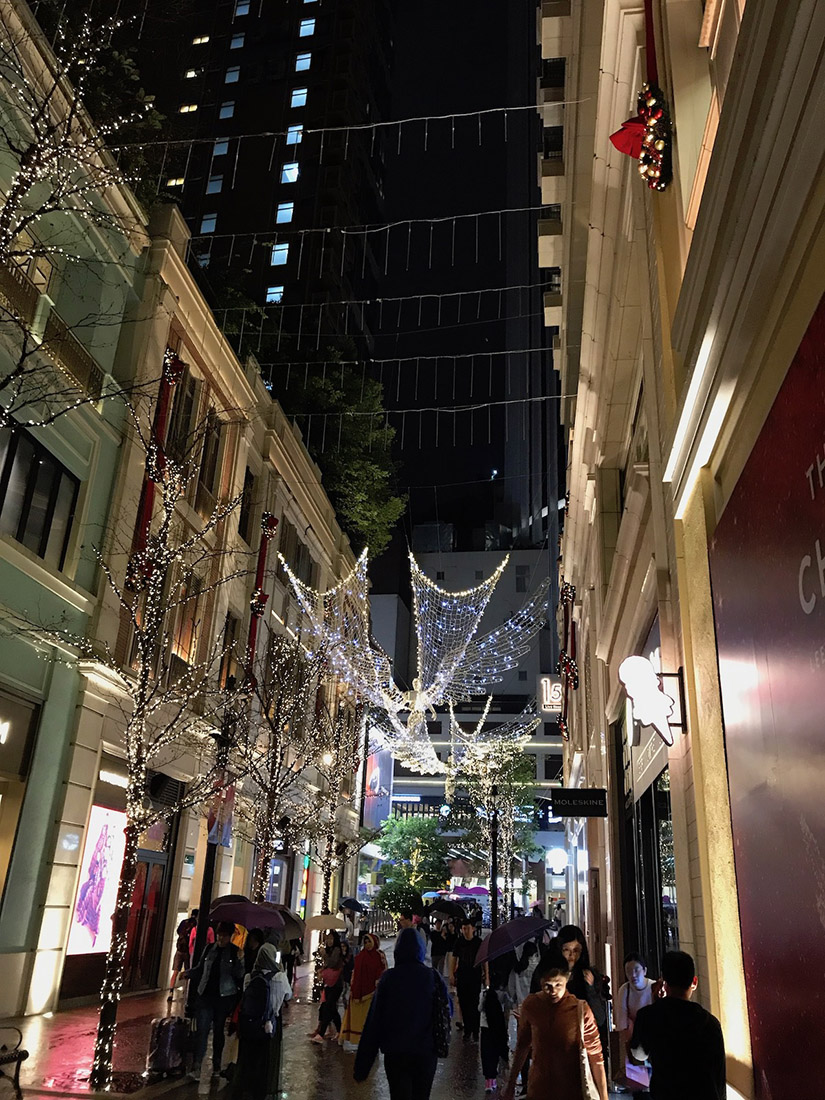
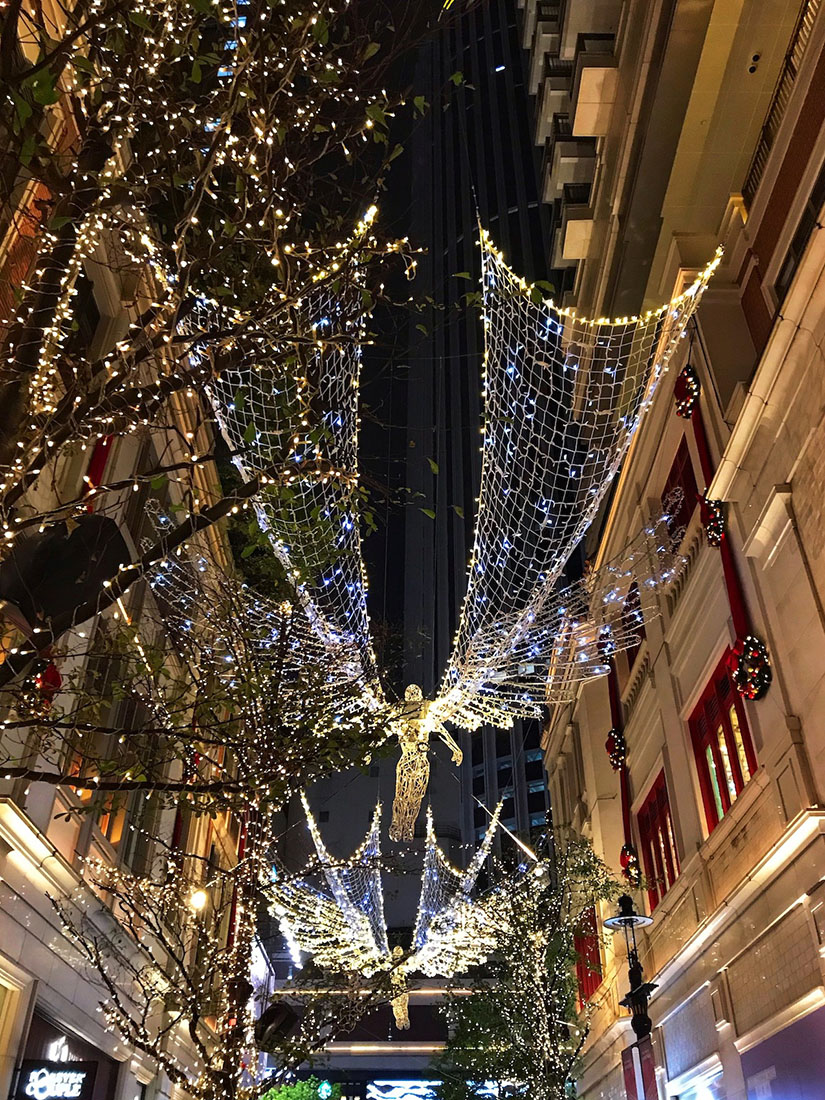
That was my very first impression of Hong Kong — and one I’ll never forget: charming angels, glowing lights, Christmas carols, the scent of vanilla… just like Regent Street at Christmas! Hong Kong reminded me so much of my beloved London.
Soaked to the bone, dragging a heavy suitcase but with light hearts, we finally made ourselves push through to the hotel—bravely ignoring the flashing neon lights, the street food stalls, and the unmistakable smell of durians.
Where to Stay in Hong Kong: Hotel Prices and Room Sizes
So, the automatic doors slide open, and we step into the cozy lobby of The Emperor Hotel, just starting to get dressed up for the New Year. The hotel is relatively new, located in Wan Chai, surrounded by towering skyscrapers and fascinating architecture. After sunset, the entire colossus sparkles with reflections, like the Eiffel Tower lighting up its neighbors. A bit kitschy — but totally justified. This is Hong Kong, after all — a city that can get away with almost anything.
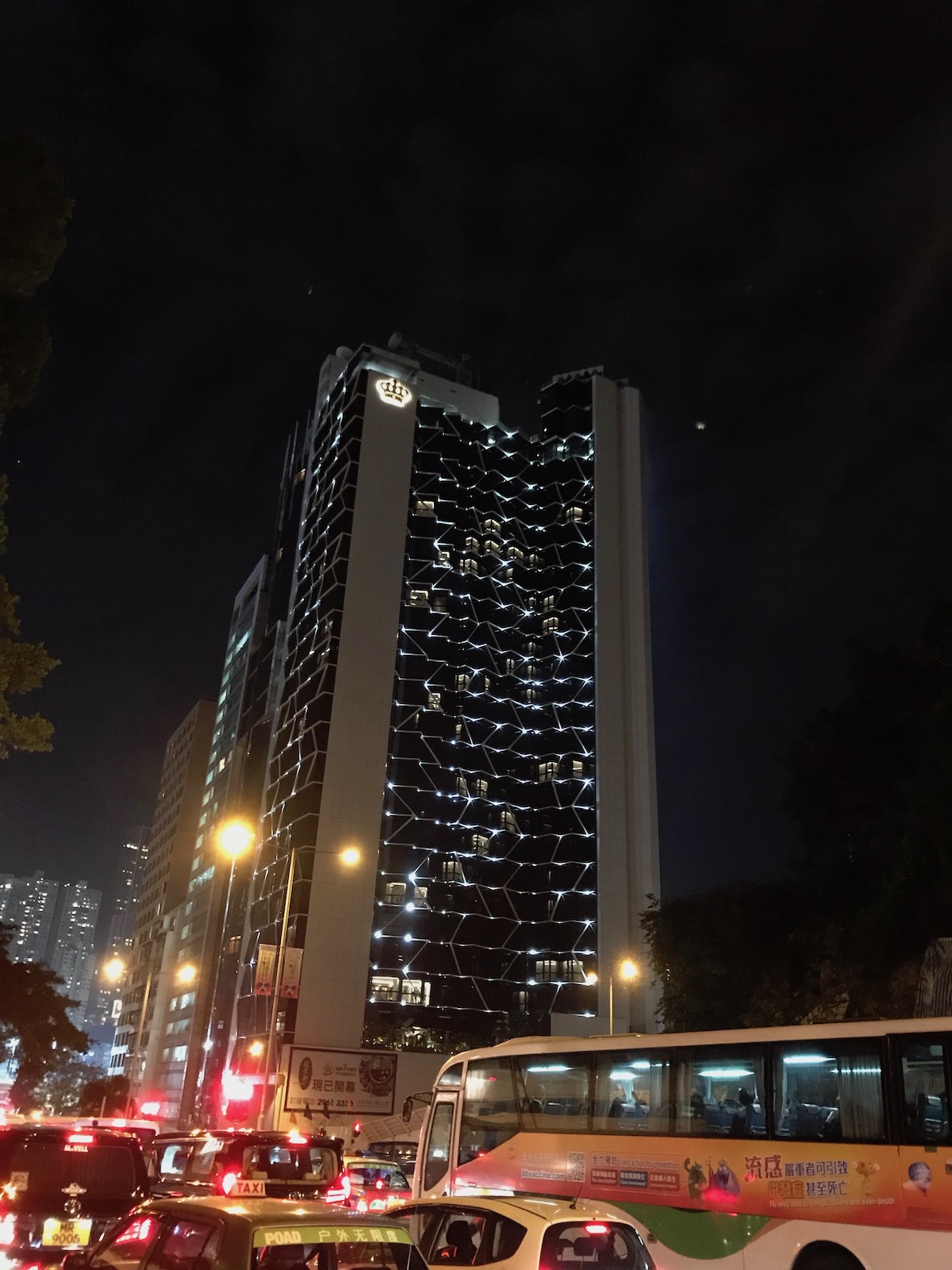
The Emperor Hotel glows in the dark like the Eiffel Tower
We take the elevator to the 16th floor and, with anticipation, turn on the lights to finally see our semi-suite with a breathtaking view of the urban jungle. And then… Wait, is this a joke?! The bed takes up 80% of the room! Where’s the wardrobe? Is that tiny nook by the bed supposed to be it — half a meter deep? My blouses are going to be crushed! Where’s the minibar? Ah — hidden in the wall next to the bathroom. And the desk? Oh, right, that narrow shelf sticking out by the window.
Our first reaction was disappointment. The room wasn’t cheap, especially for a four-star hotel with excellent ratings. And yet, that massive bed left us with only one short path from the door to the window — right across the mattress! We rushed to Booking.com, but the description and photos matched our room exactly. So, technically, they hadn’t lied… That’s when we noticed the final, barely noticeable line: the room size — 22 square meters. Now we know what that really looks like in real life.
And just like that, we were introduced to one of Hong Kong’s defining features: the price of every single square millimeter.

Our semi-suite with 80% of the room occupied by the bed


View from our room on the 16th floor of The Emperor Hotel
Hong Kong consistently ranks among the world’s most expensive cities for rent. Thanks to its booming business scene and unique landscape — a combination of mountains and harbor — residential buildings can only grow upward, not outward. Add to that the city’s strong business appeal, and you get demand for housing that constantly exceeds supply. By a lot.
So yes, having a private jacuzzi in Hong Kong is a luxury reserved for the likes of Jack Ma, or Lau Chauin, the daughter of a Chinese tycoon, who bought Asia’s priciest apartment right here in Hong Kong.
That’s why the number one tip when booking a hotel in Hong Kong is to check the room size first. Most hotels are high-quality, but room sizes can vary dramatically — even for similar categories — and so can prices.
For example, a suite at JW Marriott, offering 32 square meters, will cost you €696 for two nights, while a deluxe room at The Emperor Hotel, with 44 square meters, comes in at €487 for two nights. Both hotels have excellent locations and Booking.com ratings above 8.
By comparison, the standard room at a well-known chain like Ibis offers no more than 17 square meters, at a price of €206 for two nights.
What to Expect in Hong Kong: Cityscape, Food, and Vibes
So, after checking in and changing into dry clothes, we head out into the rainy night in search of food and neon. We make our way through the glowing, crowded neon jungle of Wan Chai. The rain keeps falling, gray panels stretch skyward for dozens of meters — we feel like characters straight out of “Ghost in the Shell” or “Blade Runner”.
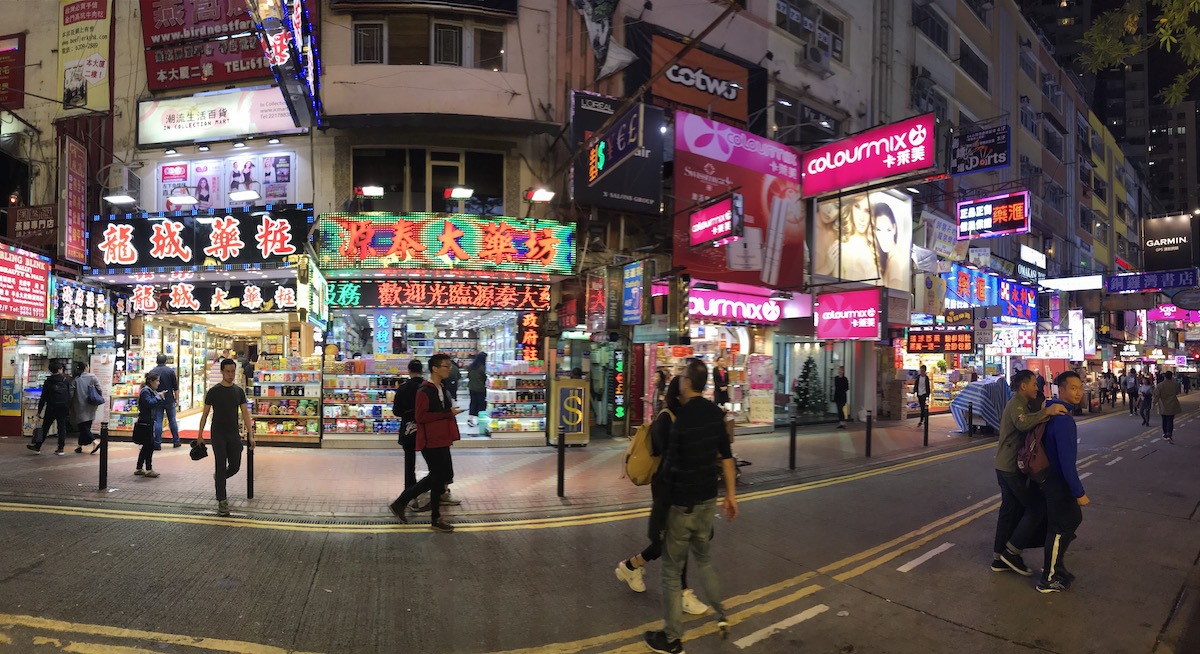
Neon all the way
The holiday lights blend into the advertising signs, the scent of kelp and rice has soaked into our clothes — which are now completely drenched again — and we still can’t find that Italian restaurant from Google Maps!
We end up in McDonald’s, because at 10 PM, it’s one of the few places still open. And let me tell you — Hong Kong McDonald’s isn’t just about ultra-caloric classics. You’ll find corn cream soup and lemon tea on the menu too. So, if your stomach’s been rebelling after two straight days of spicy Chinese food (been there, trust me), rush to McDonald’s for that comforting corn soup! Or head to Pizza Hut for a bowl of their mushroom cream soup.
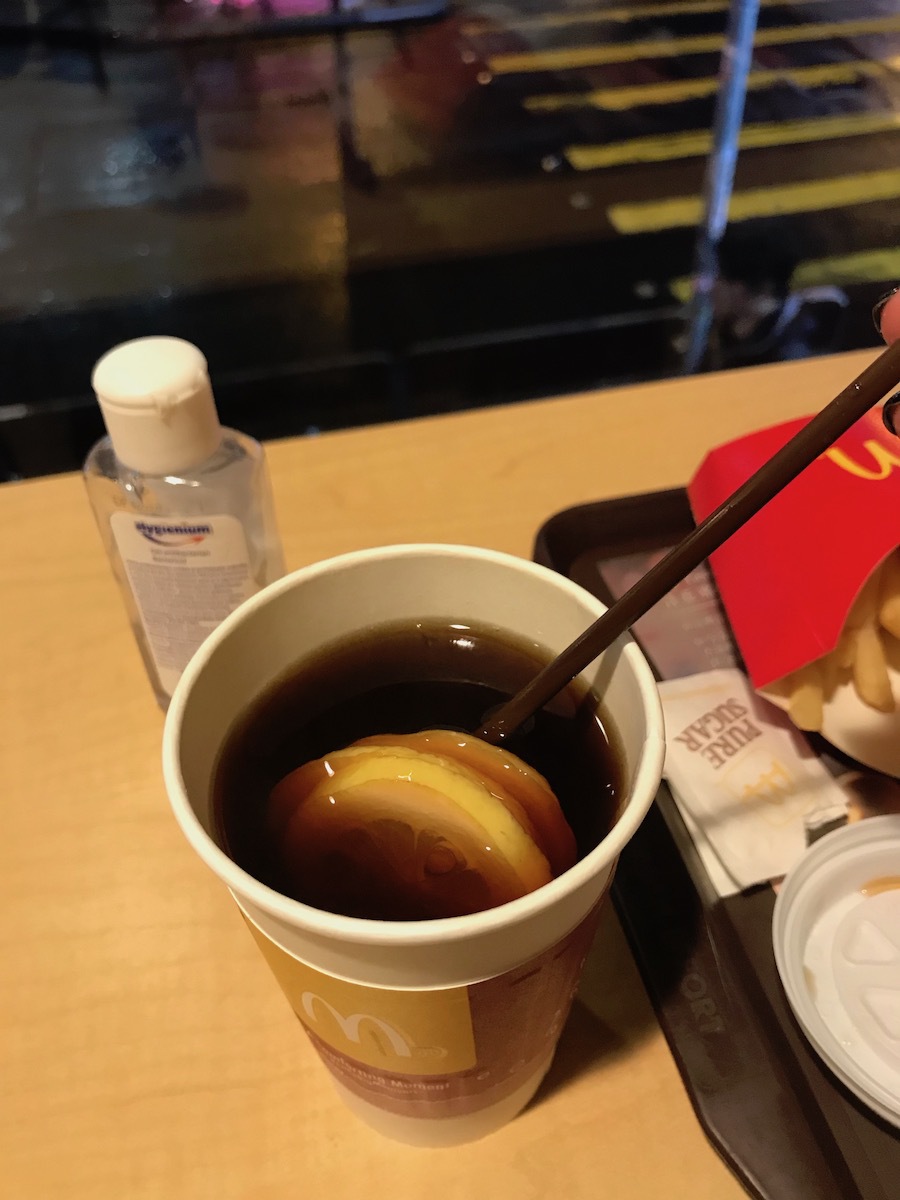
Lemon tea, McDonalds
By the way, did you know you can celebrate your wedding at McDonald’s in Hong Kong? Oh yes — since 2011, these fast-food islands have offered full-on wedding party packages. The idea proved so popular that what started with just three participating McDonald’s restaurants soon expanded to seven more.
As for Pizza Hut — no wedding services that I know of. But what you will find there is a queue system. You grab a ticket from a terminal at the entrance, then head to the back of the line and wait for your number to be called… It’s like a visa center, but for pizza and free Wi-Fi.
Well, that’s Hong Kong for you — home to over 7 million residents and welcoming another 7 million tourists every single month.
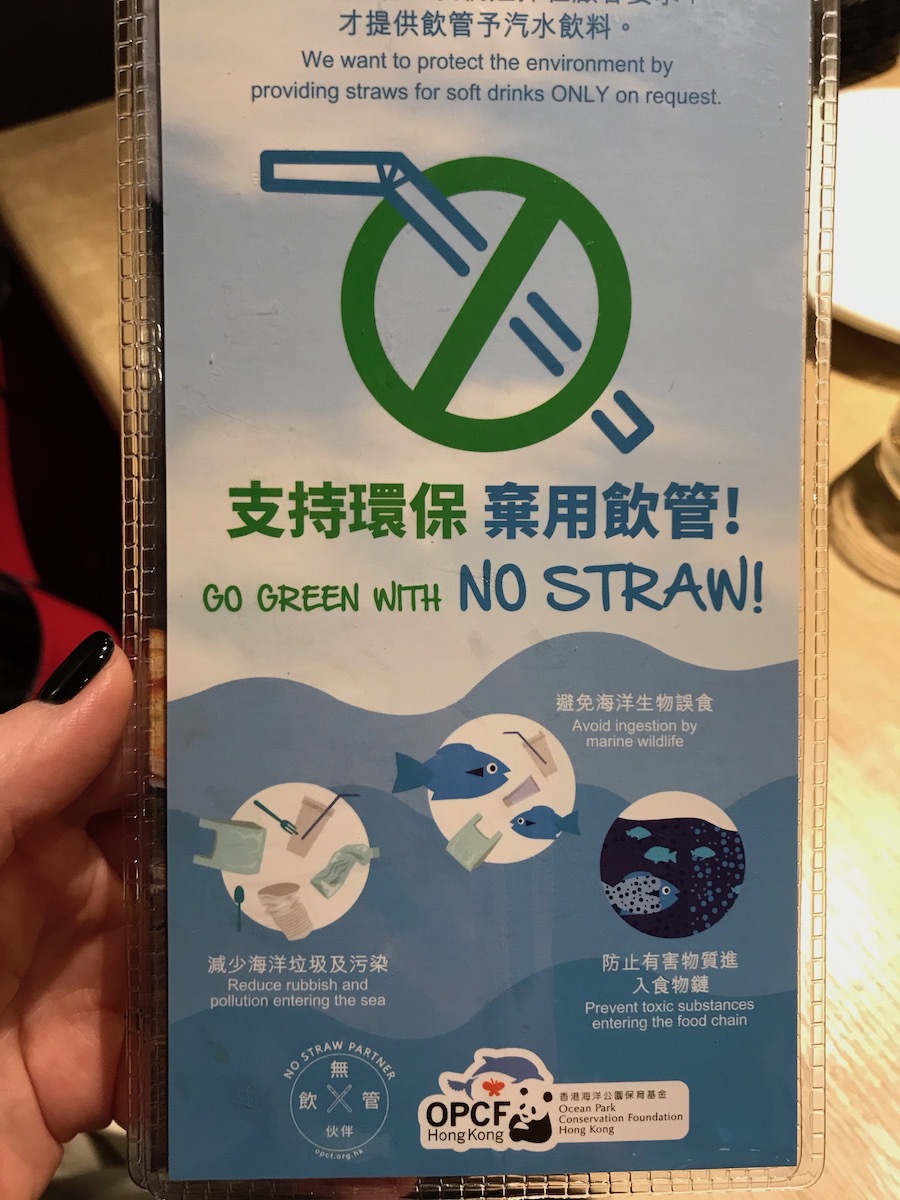
Social advertising in Pizza Hut encouraging customers not to use plastic straws
Despite the massive flow of people, Hong Kong’s transport system and public services handle the pressure incredibly well. Underground and elevated walkways, overpasses, and skybridges connecting skyscrapers — the city boasts one of the most functional, high-tech infrastructures in the world, along with exceptionally clean streets and public transit.
In fact, you can walk across central Hong Kong without ever setting foot on the ground — literally. Most skyscrapers in the city center are connected by elevated walkways. While using Maps.me to navigate, we often struggled to find pedestrian crossings at street level. Eventually, we realized that the crossings were floating in the sky, linking the towers above us. If you can’t find the path — just look up.
We had the same issue when trying to find European restaurants. Guided by Google Maps or Maps.me, we spent a while wandering at street level, only to realize later that many of the city’s restaurants are located on the 15th, 30th, or even 40th floor of a high-rise. In Hong Kong, forget searching for signs on ground-floor windows — you’ll need to carefully read the building directories posted near the entrances.
At every MTR station in Hong Kong, you’ll find a dedicated customer service booth, and in every public restroom — a detailed guide to effective hand washing. Everything here is designed with people in mind. And somehow, among 14 million others just like you, you feel like every staff member is working just for you — even during rush hour.
High-Tech Comfort
What comes to mind when you hear the word “comfort”? Maybe a chalet in the Austrian Alps with a fireplace and scattered sheepskin rugs? Or maybe… skyscrapers?
For me, comfort means simplicity, cleanliness, technology, and reliability. It’s the certainty that at 10:55 PM I can still grab a sandwich for a midnight snack and top up my Octopus card at 7-Eleven without showing my passport. We live in an era of dizzying technology and endless possibilities — and the city that feels like home should remind me of that every day.
It should make me look up, not down — not to dodge litter on the ground, but to take in what’s above.
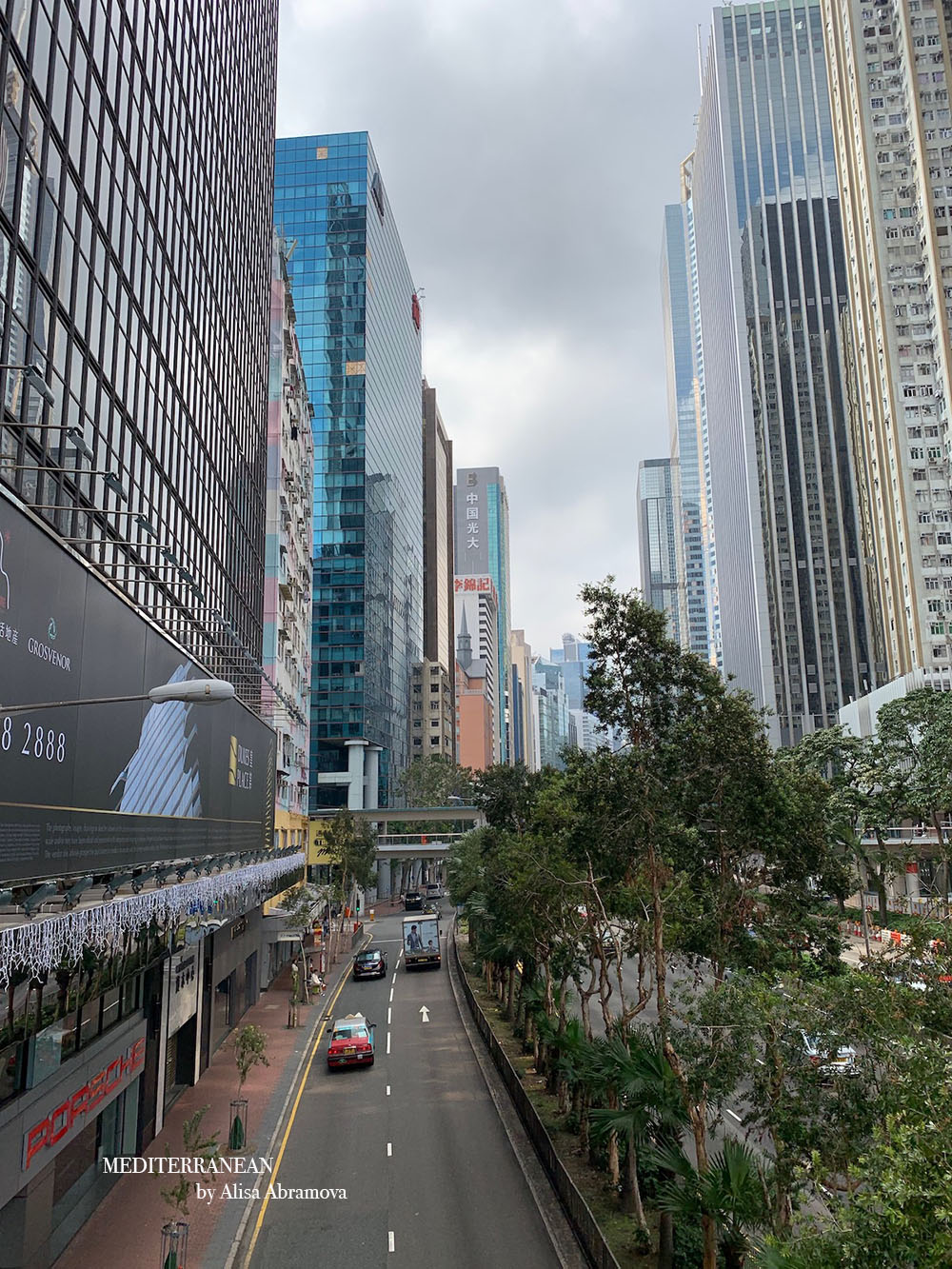
Hong Kong is my kind of comfort: high-tech, reliable, and inspiring
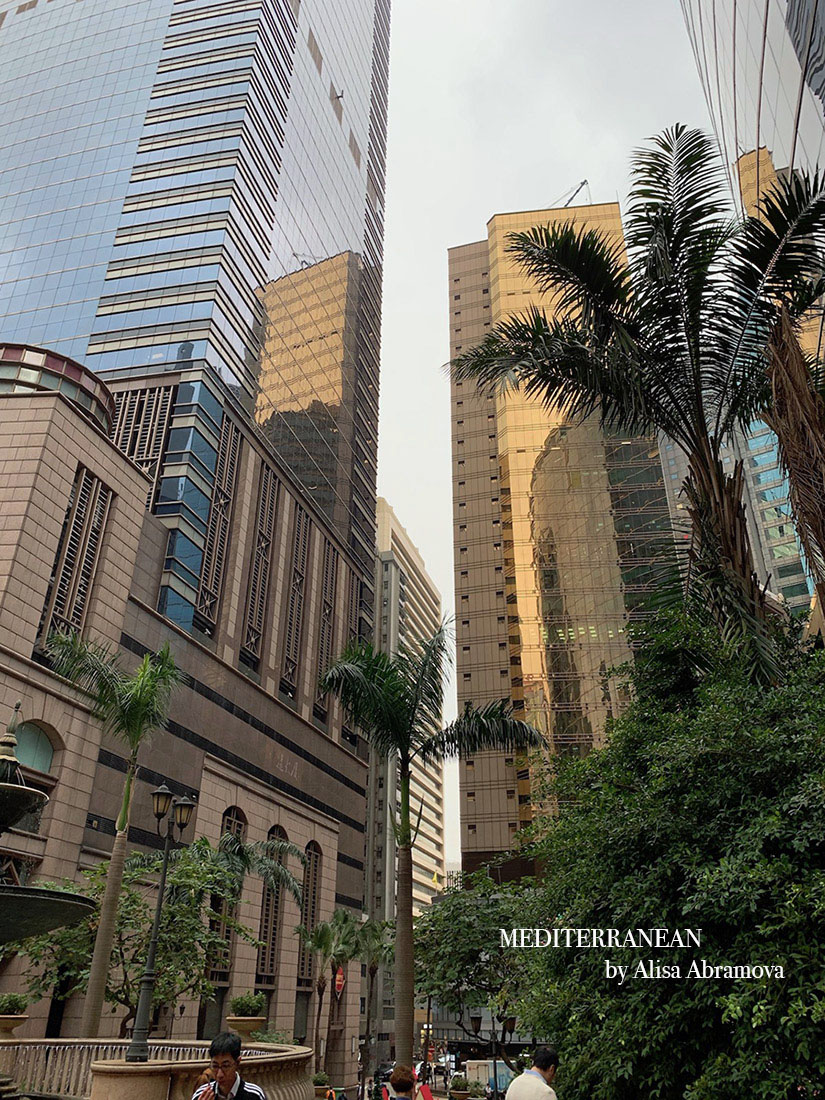
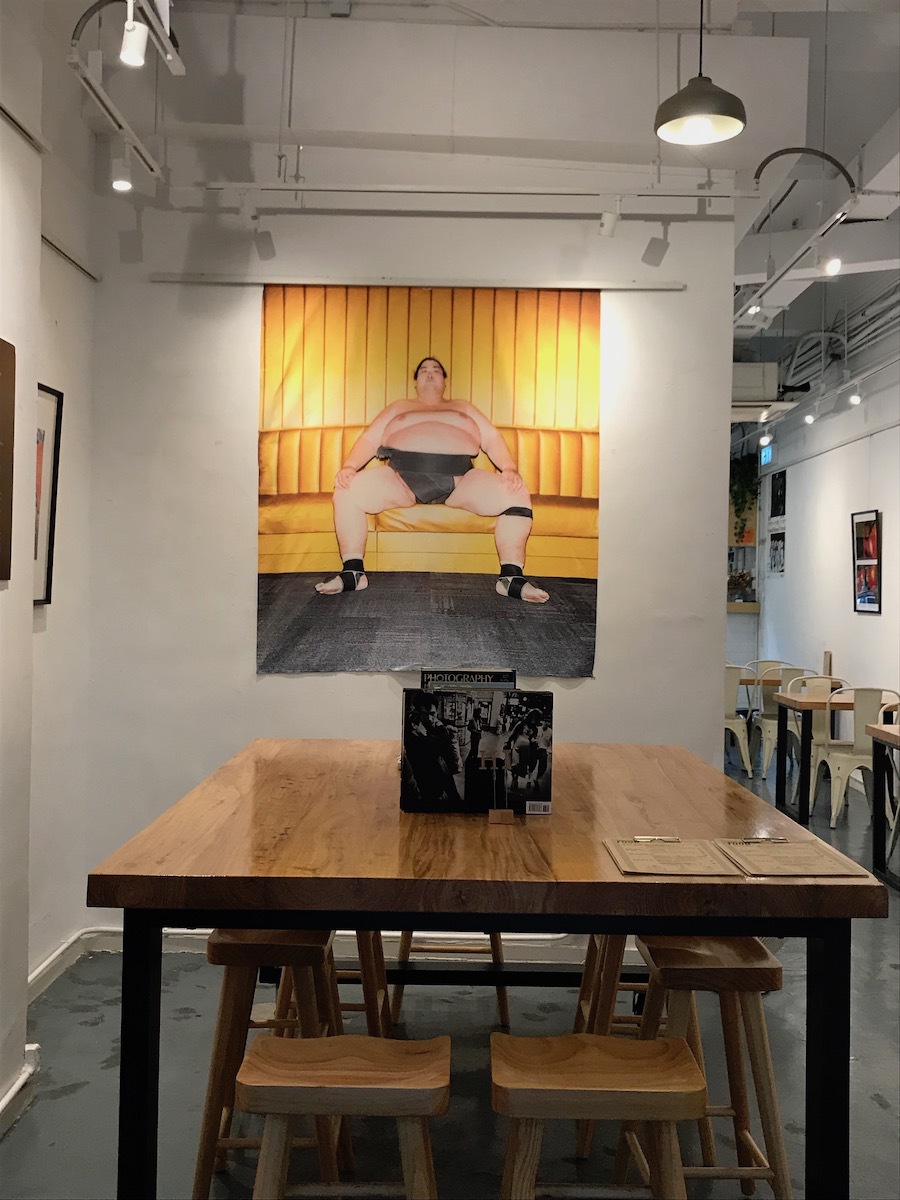
Hong Kong Transport
Metro in Hong Kong
To be honest, the phrase “rush hour in the metro” gives me mild panic attacks ever since a rather memorable incident in Moscow’s subway, when a sweet lady elbowed me straight in the solar plexus with all the force of her politeness — leaving me temporarily blind. Since then, I’ve tried to avoid subways in megacities.
But in Hong Kong, sometimes we had no choice. For example, when visiting Lantau Island, where the famous Tian Tan Buddha is located, the most efficient way to get there is by MTR — just a 40-minute train ride from Wan Chai.
And honestly, the Hong Kong MTR deserves serious respect: it’s incredibly easy to navigate, with a simple and intuitive system despite having over 200 stations. All signage and station names are also translated into English.
There were times the train doors would open on different sides depending on the station, which initially threw us off. We’d often find ourselves pushing through a tightly packed crowd just to get to the other door — because we guessed wrong. But after a couple of rides, we discovered a magical little light on the route map inside the carriage: “Please exit here” (or something like that). It lights up on the side where the doors will open.
And a special “wow” goes to the remarkable organization of not just the staff, but all Hongkongers. When we returned from Lantau during rush hour and had to transfer at a central station, I couldn’t believe my eyes. I’d never seen that many humans in one place — with lines for the escalators stretching out beyond view. And yet, everyone was calm and orderly. No one shoved, no elbows, no passive-aggressive maneuvering. Just pure urban harmony.
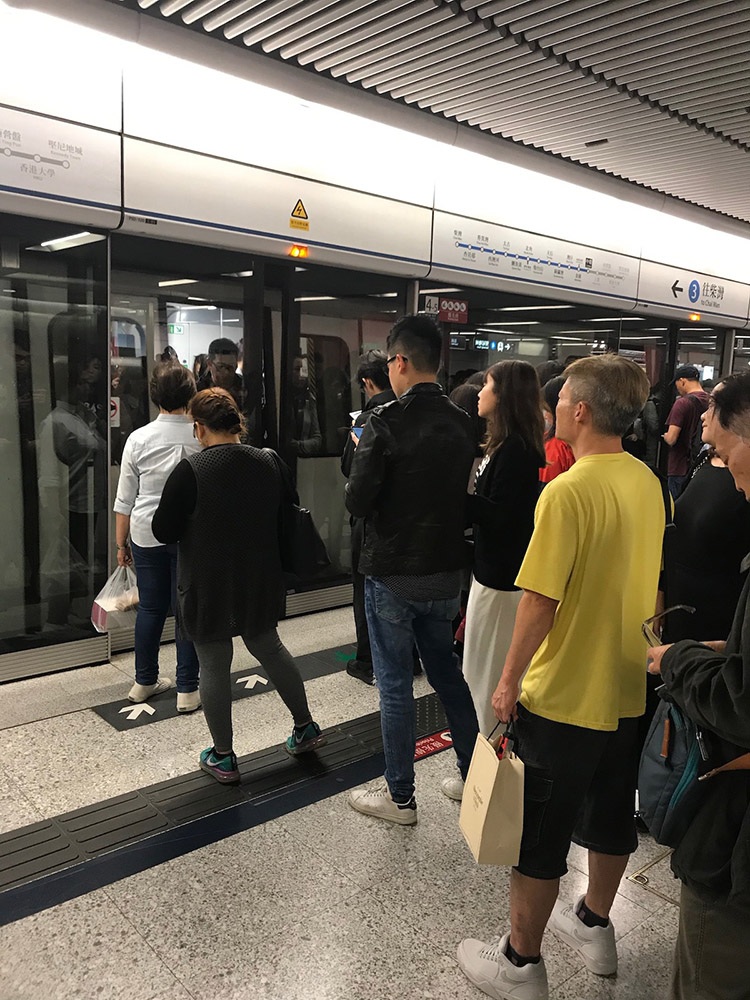
Organized queues in front of the entrance
Before the train arrives, two neat lines of passengers form at each carriage door. At every entrance, there’s an MTR staff member holding a cheerful “traffic control smiley face” sign, keeping an eye on how full the train is. Once the carriage reaches capacity, the staff member raises a red-and-yellow flag — and both lines obediently stop, patiently waiting for the next train:
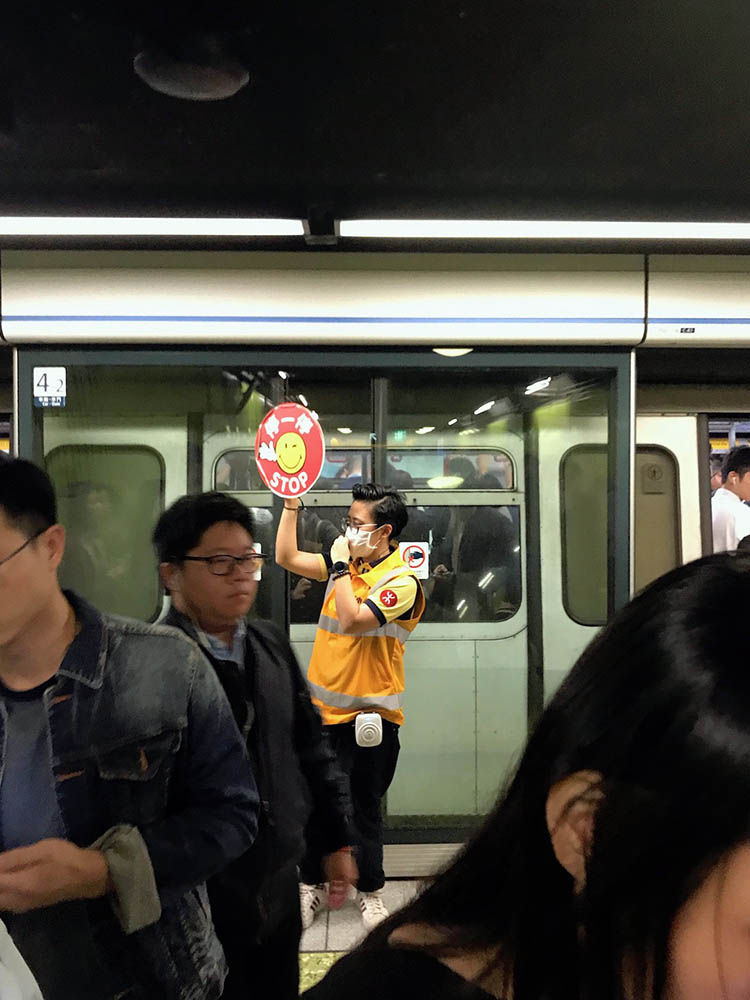
In both the metro and double-decker buses, passengers pay with the Octopus card, a smart card used for transportation and even small purchases. Fares vary depending on the distance traveled. Single-use tickets can also be purchased at machines on station platforms. You don’t even need to switch the language from Chinese — the UX and UI are that intuitive and user-friendly.
The official MTR website features a Trip Planner that helps you calculate travel time and fare between any two stops - here’s the link.
Plus, every MTR station has a Customer Service counter, where staff will happily assist you with route planning, transfers, and directions — it’s incredibly efficient.
Double-Decker Buses in Hong Kong
Double-decker buses are a beloved legacy of British colonial times — and in Hong Kong, both buses and trams come in two-story versions.
On buses, you enter through the front door and pay immediately. On trams, however, you board from the rear and pay upon exiting through the front. You can use cash, though drivers may not always have change — yet another reason to carry your handy Octopus card with you.

Double-decker tram in Wan Chai

On the upper deck of a Hong Kong double-decker
Star Ferry
🛳️ And then there’s the iconic Star Ferry, a charming historic ferry service that’s been operating since 1888, shuttling passengers between Hong Kong Island and Kowloon. Despite the availability of modern transportation, including buses and an extensive MTR system, millions of locals and tourists still prefer this scenic water route — whether for the nostalgia or to take a break from the urban buzz and soak in skyline views.
Star Ferry pier locations:
- Tsim Sha Tsui Star Ferry Pier: 🚇 MTR Tsim Sha Tsui Station, Exit L6. Walk along Salisbury Road past the Clock Tower.
- Central Star Ferry Pier: 🚇 MTR Hong Kong Station, Exit A2 or Central Station, Exit A. Walk via Man Yiu Street.
- Wan Chai Star Ferry Pier: 🚇 MTR Wan Chai Station, Exit A1. Use the skybridge to the Convention Centre, then head down to Convention Avenue.
We took the Star Ferry to the Tsim Sha Tsui Promenade, a cultural hotspot featuring major landmarks like the Hong Kong Cultural Centre, Museum of Art, Space Museum, and the Avenue of Stars — where you can shake hands with a bronze Bruce Lee and hug Jackie Chan.
Unfortunately, during our visit, both the museums and the Avenue were under renovation. So… we went to the Apple Store instead.

The Tsim Sha Tsui Promenade

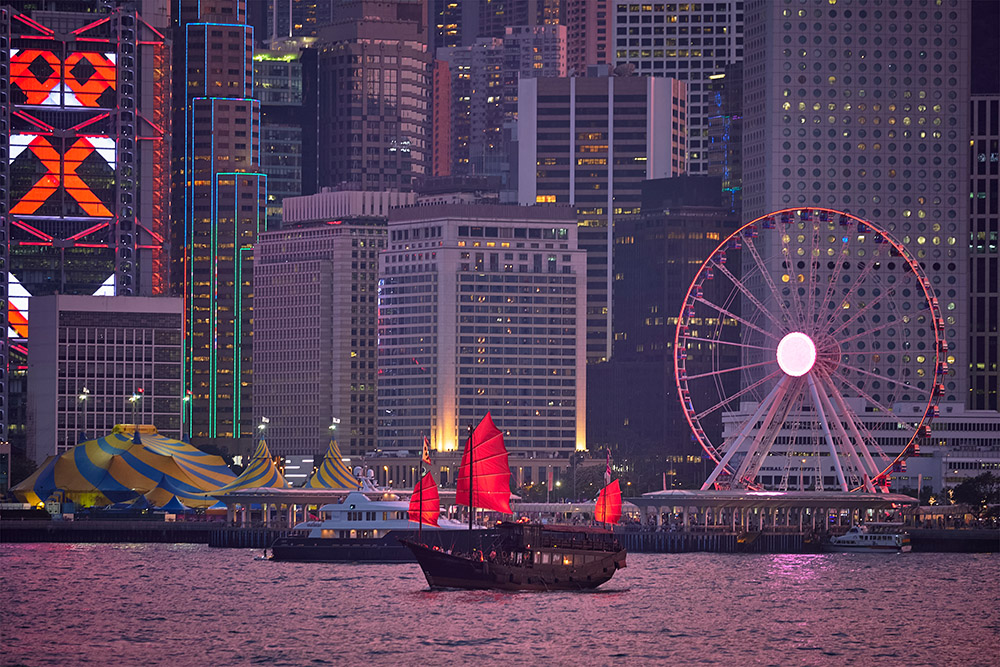
“A Symphony of Lights” (SoL) is Hong Kong’s daily light show featuring 42 skyscrapers. The show premiered in 2004 and was added to the Guinness World Records in 2005 as the world’s largest permanent light and sound show. It’s a spectacular sight to behold.
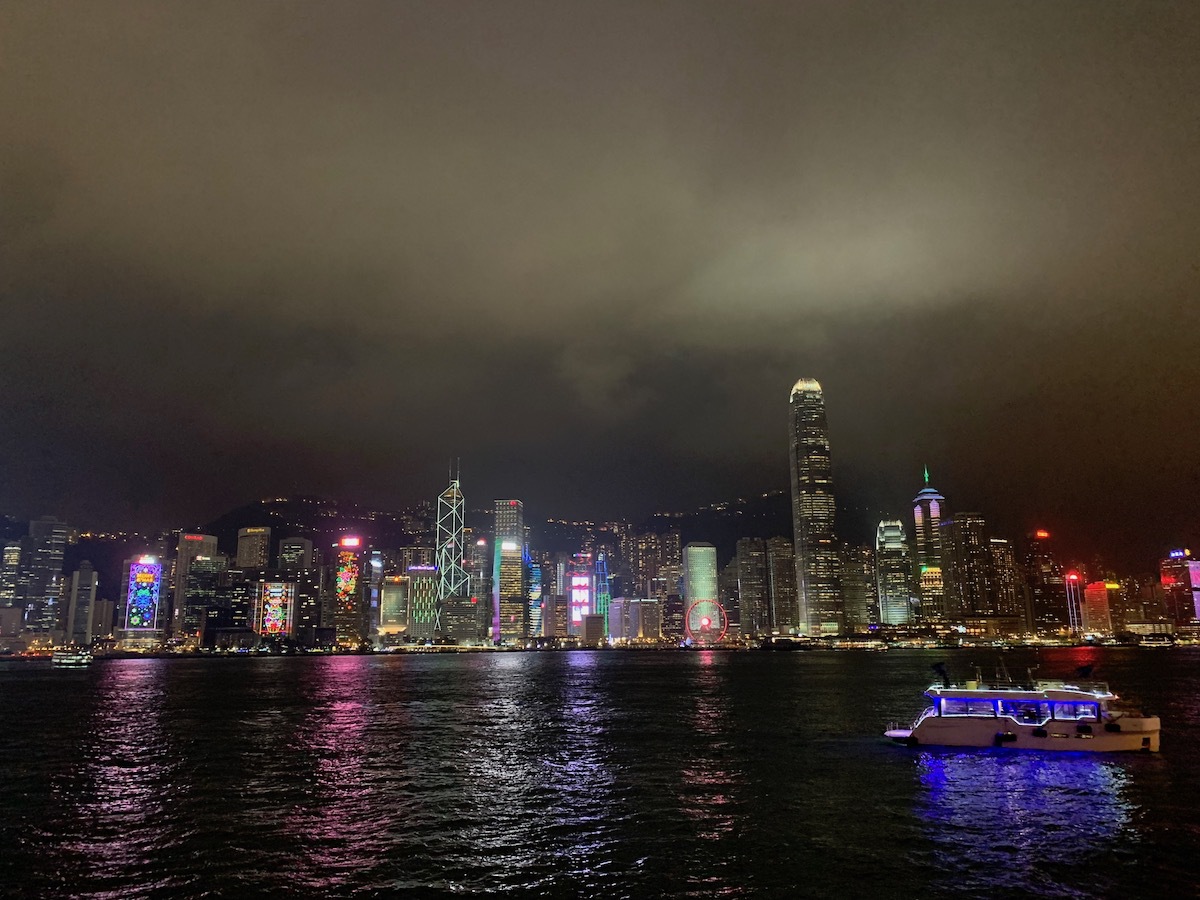
Skyscrapers are also unbelievably spectacular
Hong Kong Geography, Climate, and Best Travel Seasons
Hong Kong spans approximately 1,100 square kilometers, encompassing Hong Kong Island, the Kowloon Peninsula, the New Territories, and over 260 outlying islands. The region’s terrain is rugged and mountainous, with almost no flatlands. Stretching from the northeast to the southwest is a mountain range crowned by Tai Mo Shan, the highest peak in Hong Kong at 957 meters above sea level.
Hong Kong has a monsoon-influenced climate, which means dramatic contrasts between summer and winter temperatures. January and February see average temperatures around 16.6°C, with occasional dips to near zero. In the summer, the average rises to 28.3°C, and it’s not uncommon for it to soar above 35°C.
Around 80% of annual rainfall occurs between May and September, and fog is frequent from February to April.
Typhoon Season in Hong Kong
September is known as typhoon month in Hong Kong. Most tropical cyclones form between 5° and 20° latitude in both hemispheres, often reaching wind speeds exceeding 118 km/h. While typhoons may strike between May and November, they most commonly occur in September.
Out of the 24 tropical cyclones that form annually in the South China Sea and the Western Pacific, six may approach within 800 km of Hong Kong, and one per year typically comes close enough to potentially cause damage.
(This data is sourced from the Hong Kong Museum of History.)
Best Time to Visit Hong Kong
We visited Hong Kong in late November, which marked the beginning of the city’s mild winter. November and December are considered the best months to visit Hong Kong for tourists. Rain is rare, daytime temperatures hover around 22°C, and at night it’s a pleasant 20°C. It’s the perfect weather for all-night strolls, especially if you’re adjusting to jet lag.
You’ll find yourself surrounded by Christmas lights and festive displays in warm weather, a surreal combination that sparks wonder and a bit of cognitive dissonance — that’s the magic of Hong Kong in winter.
Why is Hong Kong So Successful in Business and Economy? The Story Behind Its Success
The city was never a militarized zone, even during its time under British rule.
Historically, Hong Kong has also maintained low levels of corruption, thanks to an efficient law enforcement system, strict oversight of public officials, and highly developed anti-corruption institutions.
This unique political culture played a key role in transforming Hong Kong into a global business hub. It’s hard to imagine international investors pouring billions into a city where their funds might be at risk due to a hypothetical conflict with Macau or Shenzhen — or worse, spent on gold-plated jacuzzis in government mansions.
Until 2019, Hong Kong consistently ranked among the most politically stable cities in Asia, offering a reliable environment for global businesses. And despite recent political shifts, Hong Kong remains a powerful financial center, still attracting companies from around the world — albeit with a more cautious outlook.
All of this is a legacy of the political and economic institutions introduced during British rule — institutions that, while shaped by a colonial past, laid the foundation for the city’s modern success.
For reference: For 150 years, Hong Kong was a British colony, receiving administrative, economic, and military support from Britain. Its fate was sealed in the 19th century, when, serving as a freight hub for Britain, it was granted the status of a “porto-franco” — a free trade zone and free warehouse.
Today, Hong Kong is neither a city nor a state, but rather a Special Administrative Region (SAR) of China. Under the principle of “One Country, Two Systems”, this unique status will remain until 2047. Hong Kong maintains its own currency, economy, tax policies, immigration system, and follows the British legal system, while China is responsible for defense and foreign policy.
Each year, China’s influence over Hong Kong has been growing, and there are concerns that after 2047, the city might become just another Chinese city with limited civil liberties and a firewall. However, one thing that remains unquestionable is the wisdom and pragmatism of China’s leaders, who set long-term goals spanning centuries. It’s unlikely that they will abandon this strategic gateway for Western investors and a window to the world. Therefore, it’s highly probable that the current status will continue, with decorative amendments to the agreement.
Today, Hong Kong offers a wide range of opportunities for businesses, including:
- Government-level guarantees
- Low inflation rates
- Minimal restrictions on financial activities
- No currency control from local banks
- A reliable currency (the Hong Kong dollar is considered one of the most stable currencies in the world)
- British legal standards that protect intellectual property
- A favorable tax system: there is no VAT, sales tax, dividend tax, customs duties, or social contributions.
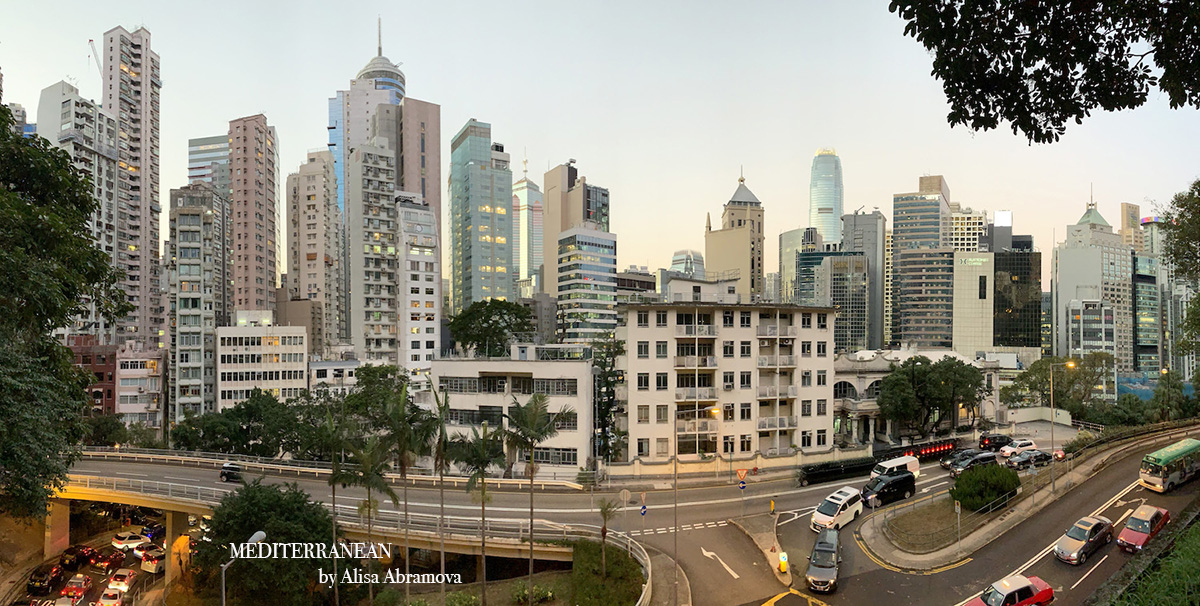
What Do We See in 2025?
According to the Economic Freedom of the World ranking, Hong Kong has been recognized as the freest economy in the world, scoring 8.58 out of 10, surpassing even Singapore and Switzerland.
Today, Hong Kong is not only a financial center but also a vital gateway between Europe and Asia, playing a significant role in international trade and especially in the re-export of Chinese goods. It is home to the highest number of headquarters of Asian corporations — more than any other city in the Asia-Pacific region. Additionally, over 70 of the world’s top 100 banks have offices in Hong Kong.
The technology sector is also rapidly growing. The Science & Technology Park offers not only modern infrastructure but also incentives for startups and high-tech companies working on innovative solutions.
This success is not due to natural resources or industrial power — there are virtually none — but rather a result of transparent governance, low corruption, respect for economic freedoms, and targeted reforms.
For example, the 2025–26 Hong Kong Budget introduced tax relief measures, including a 100% reduction in profits tax capped at HK$1,500 per business, aimed at easing financial pressures for small and medium enterprises (SMEs).
Of course, Hong Kong is not without its flaws. There is a significant income disparity, and the poverty rate reaches 20%, with many struggling to afford the high cost of living. We occasionally saw elderly people collecting boxes to recycle and raise money for rent. Indeed, for the oldest pensioners, who were not affected by the mandatory pension system introduced in 2000, surviving on the old age allowance can be difficult.
Nevertheless, Hong Kong is a global longevity leader. In 2025, the average life expectancy there is 85.77 years (88.39 years for women and 83.1 years for men) – surpassing countries like Japan, and holding the top spot in both Asia and the world for life expectancy.
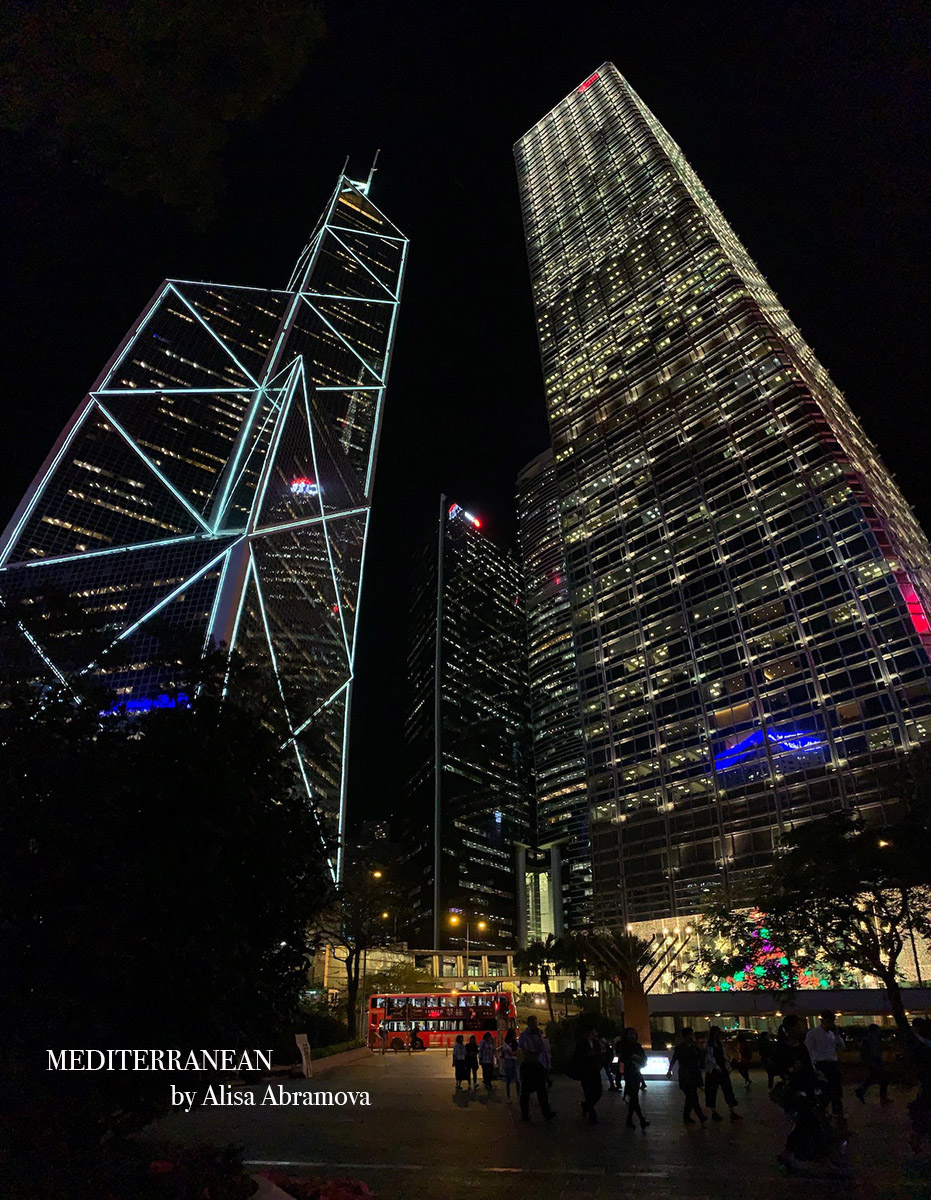
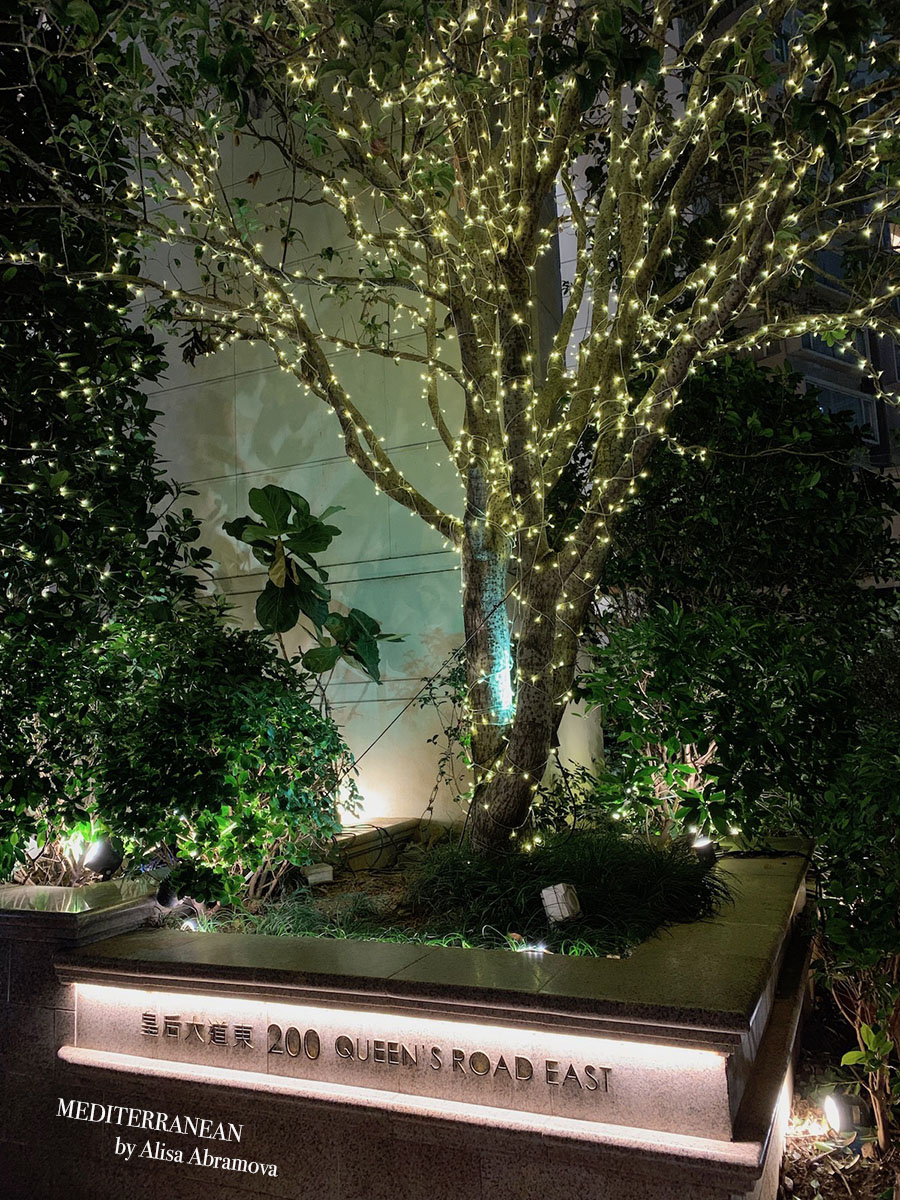
Late at night, walking near the sharp-edged Bank of China building, surrounded by fluttering reflections and blooming poinsettias, you feel like you are capable of anything – this is how energetic this place is. There’s a sense that you are part of the eternal cycle of work and inspiration, ready for new beginnings. In Hong Kong, there is only one way for a person – upwards (and with a 3.2% unemployment rate and new offices opening every year, this is certainly true).
Sincerely,
Alisa Abramova